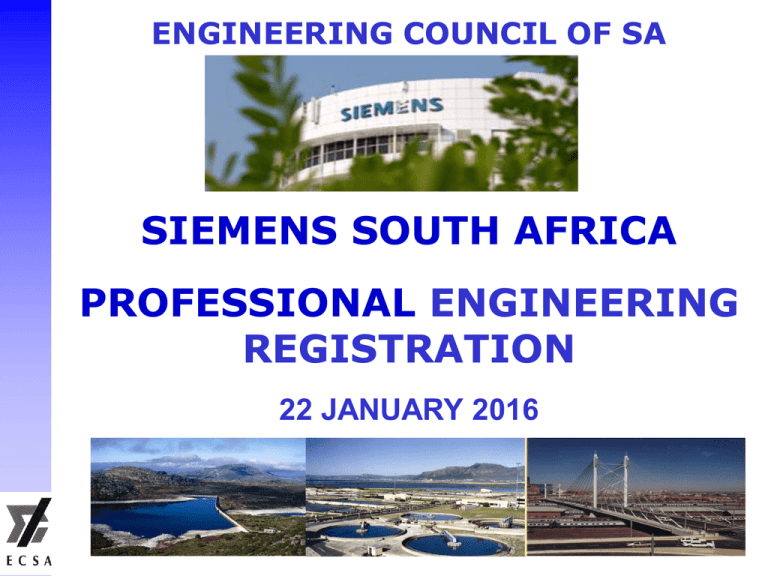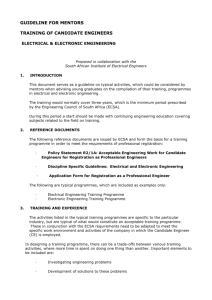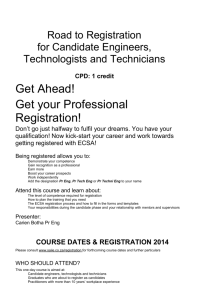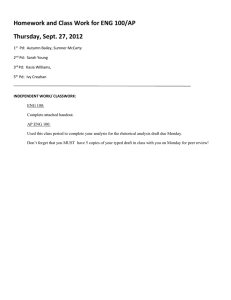siemens south africa professional engineering registration
advertisement

ENGINEERING COUNCIL OF SA SIEMENS SOUTH AFRICA PROFESSIONAL ENGINEERING REGISTRATION 22 JANUARY 2016 1 PROFESSIONAL REGISTRATION WITH THE ENGINEERING COUNCIL OF SOUTH AFRICA DU TOIT GROBLER IntPI(SA)(EE), PR ING(EE), PR DIPL ING(EM) FELLOW SAIEE, SENIOR MEMBER ICMEESA BSc (Ing)(Elek)(Pret), MDP(Unisa) GCC (Elec & Mech) (Factories, Mines & Works) du.toit.grobler@gmail.com 083-666-6855 (m) 011-465-3768 (h) 086-512-6208 (f) WHAT IS A PROFESSION? • “ A profession is a learned calling which requires advanced knowledge, understanding and abilities gained from intensive and specialized education, training and practical experience.” • “Members of a profession limit their activities to their areas of knowledge and experience, doing so out of a commitment to serve and protect the public.” • “Professional practitioners ensure that their competence is maintained throughout their careers.” 3 PROFESSIONAL REGISTRATION : ENGINEERING Professions Worldwide - Based on two legs : - Statutory Regulation: ECSA - Voluntary Associations: Almost 50 recognised by ECSA Two Registration requirements: - Academic exit level qualification (Educational standard = Stage 1) - Practical / technical post qualification training at the appropriate Engineering level for the category and in the discipline of registration concerned (Professional 4 development = Stage 2) WHAT IS ECSA? o STATUTORY BODY o ACADEMIC STANDARDS o PROFESSIONAL DEVELOPMENT and REGISTRATION o IDENTIFICATION of ENGINEERING WORK o PROFESSIONAL CONDUCT o GOVERNMENT LIAISON o INTERNATIONAL RECOGNITION 5 WHY REGISTER? There is Risk associated with all Engineering work which has potential adverse consequences and therefore, must be carried out - To safeguard health and safety of the public - Responsibly and ethically - Economically - Using available resources efficiently - In an environment sound and sustainable way, and - Managing risks throughout the entire lifecycle of a system. Consequently, Engineering is a regulated profession and through registration any holder of a tertiary qualification in engineering can become part of it. 6 Professional Development Model 5 - Yearly Renewal of Professional Registration Practice (Life long) Observe Code of Conduct Maintain Competence through CPD Pay annual fees Professional Registration Training & Experience (3 yr min) Meet Standard for Professional Competency – Stage 2 Candidate Registration Meet Standard for Engineering Education- Stage 1 Graduation / Certification Accredited Programme 7 THE ENGINEERING FAMILY Four professional categories • PROFESSIONAL ENGINEER (Pr Eng) • PROFESSIONAL CERTIFICATED ENGINEER (Pr Cert Eng) • PROFESSIONAL ENGINEERING TECHNOLOGISTS (Pr Tech Eng) • PROFESSIONAL ENGINEERING TECHNICIAN (Pr Techni Eng) 8 PROFESSIONAL ENGINEER (Pr Eng) Qualification required: BSc(Eng)/BEng/BIng Experience standards characterised by: • Activities that are essentially intellectual • Analysing and solving complex problems • Developing and applying new technologies creatively and innovatively • Exercising Professional judgement • Managing resources 9 PROFESSIONAL CERTIFICATED ENGINEER (Pr Cert Eng) Qualification required: One of Seven GCCs PROFESSIONAL ENGINEERING TECHNOLOGISTS (Pr Tech Eng) Qualification required: BTech(Eng) Experience standards characterised by: • Solving broadly defined problems through application of proven techniques and procedures • Developing, maintaining and managing today’s technologies • Exercising Professional judgement • Managing resources • Take legal responsibility for the safety of personnel, plant and equipment 10 PROFESSIONAL ENGINEERING TECHNICIAN (Pr Techni Eng) Qualification required: National Diploma (Eng) Experience standards characterised by: • Solving well defined problems using proven techniques and procedures • Under supervision however assumes technical responsibility • Contributing to implementation, operation and maintenance of products, equipment, processes and services 11 ELEVEN OUTCOMES REQUIRED Grouped into five sets: Group A: Knowledge-based Engineering problem solving Outcome 1: Define, Investigate and Analyse Engineering problems Outcome 2 : Design or develop solution to Engineering problems Outcome 3 : Comprehend and apply knowledge: Principles, specialist knowledge, jurisdictional and local knowledge. 12 OUTCOMES CONTINUED… Group B: Manage Engineering Activities. Outcome 4: Manage Part or all of one or more Engineering activities Outcome 5: Communicate clearly with others in the course of his or her Engineering activities 13 OUTCOMES CONTINUED… Group C: Impacts of Engineering Activity Outcome 6: Recognise and address the reasonably foreseeable social, cultural and environmental effects of Engineering activities Outcome 7: Meet all legal and regulatory requirements and protect the health and safety of persons in the course of his or her Engineering activities. 14 OUTCOMES CONTINUED… Group D: Exercise judgment, take responsibility and act ethically Outcome 8: Conduct Engineering activities ethically Outcome 9: Exercise sound judgment in the course of Engineering activities Outcome 10: Be responsible for making decisions on part or all of Engineering activities 15 OUTCOMES CONTINUED… Group E : Continuing Professional Development Outcome 11: Undertake Professional Development activities sufficient to maintain and extend his or her competence. 16 HOW AND WHEN TO REGISTER AS A CANDIDATE Step 1:“Candidate” Registration in order to have qualifications evaluated. Candidate Engineer BSc(Eng)/BEng/BIng Candidate Eng Technologist BTech (Eng) Candidate Certificated Engineer Government Certificate of Competency ˗ one of seven Candidate Eng Technician NDip (Eng) • Immediately on completion of Education qualification; • All foreign qualifications are referred to ECSA’s Qualifications Evaluations Committee (QEC); • Allow three month for processing of applications. 17 HOW AND WHEN TO REGISTER Step 2: Professional Development while employed Commitment and Undertaking (CU) • Employer CEO registers a CU with names of professional mentors • Undertakes to train “candidate” engineering persons in accordance with ECSA’s policy and discipline specific guidelines • Ensures internal training programme is in place and being implemented • Ensures training take place under a professional mentor 18 DISCIPLINE SPECIFIC TRAINING GUIDES FOR CANDIDATE ENGINEERING PRACTITIONERS • Aeronautical Engineering • Agricultural Engineering • Chemical Engineering • Civil Engineering • Electrical Engineering • Industrial Engineering • Mechanical Engineering • Metallurgical Engineering • Mining Engineering • Marine Engineering 19 TRAINING PERIOD Minimum of three (3) years post qualification. It generally takes longer than three (3) years to acquire competencies. Imperative that training programmes are well developed, managed and implemented. Spending time on a particular element of training without a qualitative objective will not ensure achievement of the required level of competency for that level. 20 TRAINING PROGRESSION Level Nature of Work Responsibility Level of Support 1. Being Exposed Induction/ Observes None 2. Assisting Performs under close supervision Limited for work output Coaches and feedback 3. Participating Performs under limited supervision Full for supervised work Progressively reduces support 4. Contributing Performs with approval of work output Full to supervisor for quality of work Candidate articulates own reasoning and compares 5. Performing Works without supervision Full as appropriate for a registered person Candidate takes on without support/ limited guidance Explains challenges/ solutions Typical time 6 to 12 months 12 to 18 months 12 months 21 DEVELOPING PROFESSIONAL COMPETENCE During the post graduate period of training and experience, the candidate is in employment and works with and under the supervision of qualified Engineering supervisors and professional mentors. A professional mentor guides the candidate’s professional development (with assistance of the Engineering supervisor). Training process may involve structured activities, including induction and training courses on specific skills or technologies. 22 PLANNING PRINCIPLES: TRAINING PROGRAMMES Two principles must be followed by supervisors and mentors when planning training programmes for candidates : 1. A variety of work activities: Variety may be obtained at the various stages in the lifecycle of an engineering activity : conception, planning, design, construction, implementation, operation and closure. Associated with this lifecycle are specific functions, including commissioning, testing, improving, troubleshooting. Candidate should experience several stages in the lifecycle of a project or projects. 23 PLANNING PRINCIPLES : TRAINING PROGRAMMES (cont…) 2. Increasing responsibility and accountability within the organization must be imposed on and accepted by the candidate until he/she is capable of accepting professional responsibility in making and executing engineering decisions at the full professional level. . 24 PROFESSIONAL REGISTRATION PROCESS • Registration process for all categories of registration basically the same • Exception: Pr Eng category which has a compulsory professional review • Other categories have the discretion to call applicants in for an interview 25 APPLICATION REQUIREMENTS (LEGACY and NR SYSTEMS - ALL 4 CATEGORIES) Personal details (Forms A = engineers, B = technologists, C = technicians and D = certificated engineers) Certified copies of qualification and transcripts Training and Experience Summary (TES) Training/Experience Reports (TER) (max. 2000 words total) – verified by supervisors Project/Design Report – describe your competence in the 11 outcomes) (Legacy System Only) Engineering Report (ER) (max. 6000 words) – all 11 outcomes, selfassessment (NRS only) Initial Professional Development Report (IPDR) At least 2 Confidential Referee Reports from registered professionals Proof of membership of Voluntary Associations Application fee 26 TIPS ON THE PREPARATION OF EXPERIENTIAL AND ENGINEERING REPORTS • Sell yourself • Write in the first person • Elaborate on what you have done • Describe your level of responsibility • Be specific – do not generalise • Cover all periods since you obtained your exit level qualification 27 NEW REGISTRATION SYSTEM (NRS) Implemented w.e.f. April 2013 for the Engineer category and during 2015 or later for the Technologist, Technician and Certificated Engineer categories. New policy guideline documents substituted the legacy current documents. New documents are being made available on the ECSA website on: http://www.ecsa.co.za/index.asp?x=NewReg 28 NEW REGISTRATION SYSTEM (NRS) (Continued) • All applicants submitting after 1 April 2016 would therefore also have to provide New Registration System evidence of competence and will be assessed against Competency Standard R-02-PE. 29 ENGINEERING REPORT • Engineering Report, maximum 6 000 words covering aspects of work at the Perform Level that demonstrates an applicant’s fulfillment of the 11 outcomes. • Not “simply report on a specific project.” Work drawn on for the report does not have to be project based; in an operational environment, problem solving and engineering management may provide evidence of performance against required outcomes. • Report should be reflective rather than narrative. It is also a test of the applicant’s written communication ability. • The report must include a self-assessment of the 11 outcomes in terms of the Training Progression table. 30 Engineering Council of SA Page No: ____ of___ (05/05/2014) Form AN3 R-03-ER-PE Engineering Report (ER) as part of Application for Registration as Professional Engineer Applicant: In terms of my general declaration, I confirm that this report was written by me for the purpose of this application Selfevaluation per Signature: Competency/ Date: Word Count: Reference to TERs Describe all eleven (11) competencies Holistic Self Evaluation 31 Engineering Council of SA Form B2.3 ER (17/07/2014) Engineering Report as part of the application for registration as Professional Technologist Outcomes and Criteria Cross-reference to TER Outcome 1: Define, investigate and analyse broadly-defined engineering problems. 1.1 State how you performed or ? Period No: contributed in defining engineering problems leading to an agreed definition of the problems to be solved. 1.2 State how you performed or ? Period No: contributed in investigating engineering problems including collecting, organising and evaluating information. 1.3 Describe how you performed or ……. ? Period No: Outcome 2: Design or develop a solution to broadly-defined engineering problems. 2.1 Describe how you designed or …….. ? Period No: 32 IN CONCLUSION 1. ECSA is the custodian of the values and ethos of the profession. 2. As a registered professional you should remember that the profession operates in a global environment. 3. Whilst it is necessary to regulate the profession, it cannot happen in isolation to the rest of the world. 4. One of ECSA’s main objectives will always be to uphold the integrity and dignity of the profession. 5. We wish you well in your Engineering Career and hope to see your application to register soon! 33 THANK YOU FOR YOUR ATTENTION! Website E-mail Tel No Offices : www.ecsa.co.za : engineer@ecsa.co.za : (011) 607 9500 : Waterview Corner, Building 2, Ernest Oppenheimer Avenue, Bruma, Johannesburg 34


